Planning to grow a business beyond your home country with global SEO? That’s a smart move. More markets mean more customers and more revenue for your business. Yet, simply translating your site won’t be enough. You’ll need a well-planned strategy that takes into account technical SEO, keyword research, and content localization.
In our guide, we’ll show you a step-by-step process on how to launch an international SEO campaign. We’ll also share the best practices on how to structure your site, optimize for local searches, and avoid the mistakes that keep you away from ranking globally.
- Global SEO can help businesses reach more international customers and sales.
- People in other countries search differently, so you need to adapt your strategy accordingly.
- The content on your site should be localized and sound familiar to international audiences to build trust.
- Hreflang tags help show the right language version of a page so users don’t end up on the wrong one.
- Your website structure (country domains, subdirectories, or subdomains) affects rankings and how search engines understand your site.
What is Global SEO (or International SEO)?
Global SEO is the process of optimizing your website to rank in Google and other search engines across foreign countries and languages. In practice, it means the same thing as international SEO, so you will see us using these terms interchangeably in the text.
A global SEO strategy can help you tap into new markets, get more people to know about your brand, and increase revenue. For example, if you’re a B2B SaaS company that sells CRM software, you could start landing enterprise clients in Europe or India simply by localizing your website and optimizing its technical aspects.
To demonstrate this, here’s the keyword data for the term “CRM software”. You can see below that the global volume is 133,000, but less than half of it comes from the US. It shows that there’s a demand for this product in other countries.
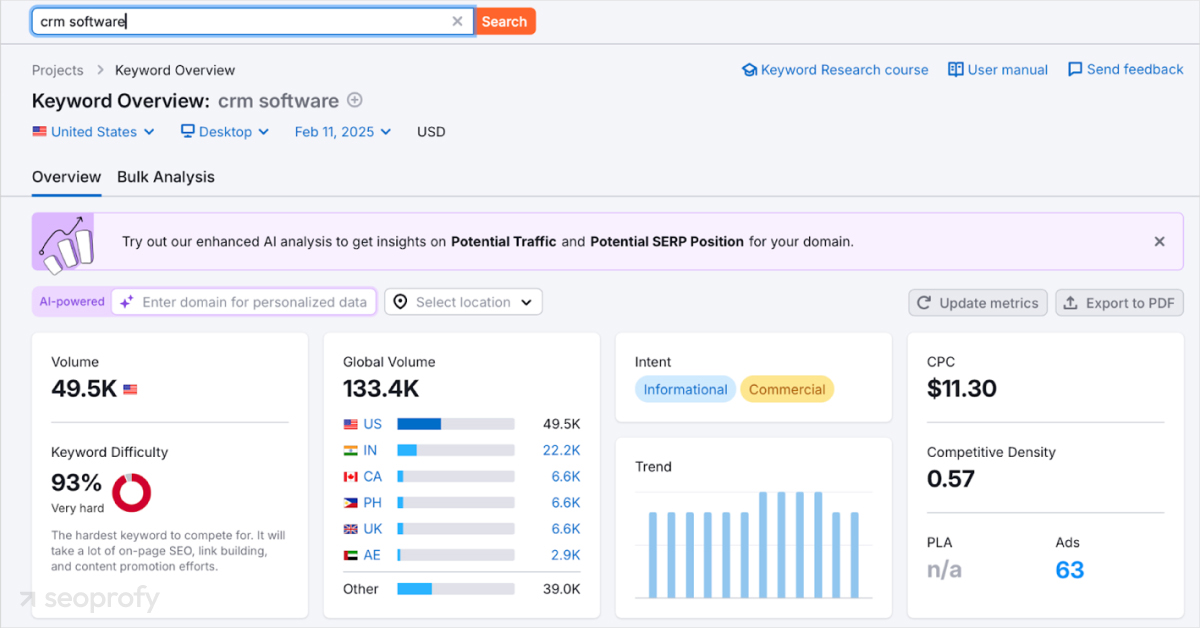
A site that’s localized for international markets can also build credibility. After all, customers will be more likely to sign up if they see content in their language, pricing in their currency, and familiar payment options.
International vs. Local SEO
Both international and local SEO help businesses show up in search results, even though they work in different ways. The first one helps companies reach more people from global markets, whereas the latter brings in prospects from a specific city or area.
If you’re a law firm in New York and only serve local clients, then it’s a better decision for you to invest in local SEO. Your main priorities will be to rank for local searches and appear in Google Maps results.
On the other hand, if your company sells software to businesses and wants to attract more traffic and sales from other countries than where you’re located, then you need an international SEO strategy. To make it easier to understand, here’s a side-by-side comparison of the two:
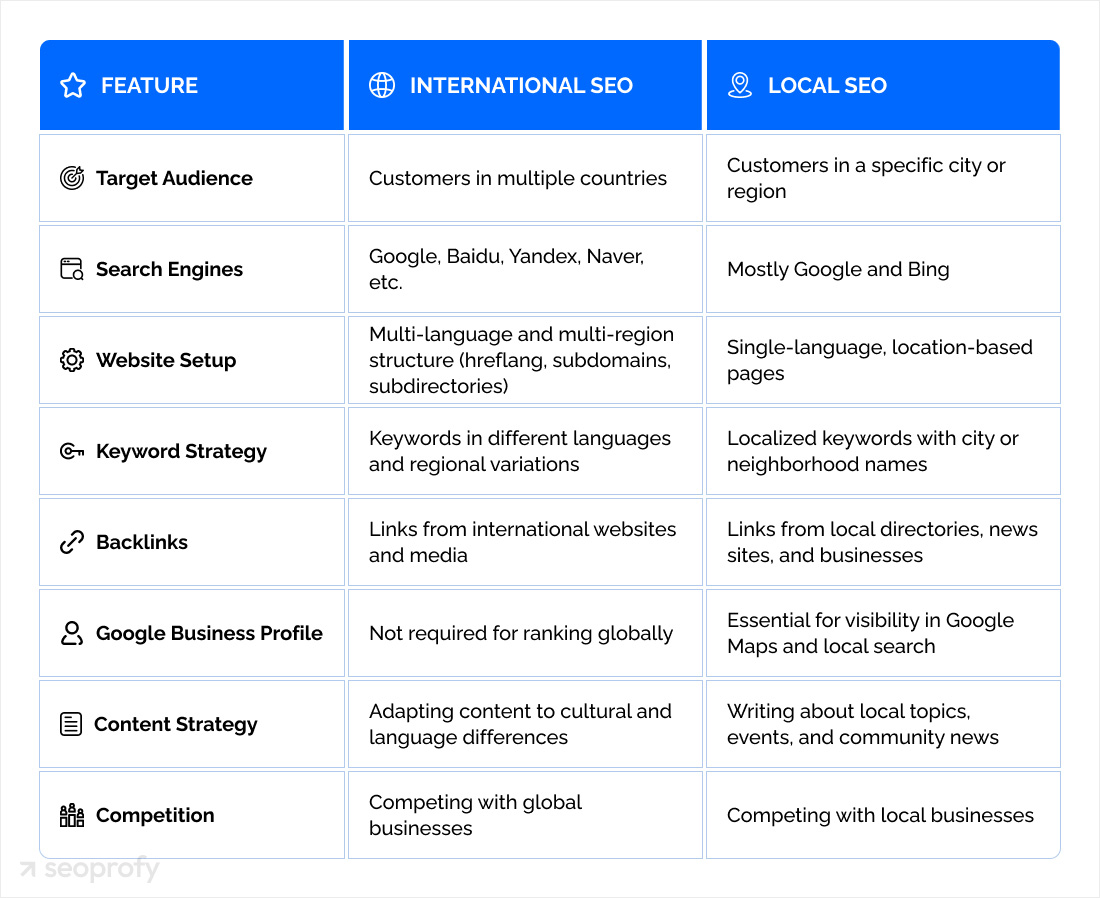
| Feature | International SEO | Local SEO |
| Target Audience | Customers in multiple countries | Customers in a specific city or region |
| Search Engines | Google, Baidu, Yandex, Naver, etc. | Mostly Google and Bing |
| Website Setup | Multi-language and multi-region structure (hreflang, subdomains, subdirectories) | Single-language, location-based pages |
| Keyword Strategy | Keywords in different languages and regional variations | Localized keywords with city or neighborhood names |
| Backlinks | Links from international websites and media | Links from local directories, news sites, and businesses |
| Google Business Profile | Not required for ranking globally | Essential for visibility in Google Maps and local search |
| Content Strategy | Adapting content to cultural and language differences | Writing about local topics, events, and community news |
| Competition | Competing with global businesses | Competing with local businesses |
Quite often, companies need to use both strategies. This is common for retail chains, franchises, and hospitality businesses that have physical stores or service locations in multiple countries. At the end of the day, it all comes down to who you’re trying to reach and where your customers are.
Now that you know the difference between the two and how they can work together, let’s look at when a global SEO strategy makes sense for your business:
- You want to expand to new markets and need people to find you online.
- You see demand for your products or services in other countries.
- Your competitors are already ranking internationally.
- Your website appears in international searches but isn’t optimized for those users.
If any of these resonate with you, it might be time to start optimizing for a global audience. And below we’ll show you exactly how you can do it.
6 Steps to Start an International SEO Campaign
The decision to go international needs to be well thought out, as there are many details to consider. You need to do your research and decide on the budget and goals, but also think about the plan on how you’ll achieve them. To make this process easier, we’ve created a step-by-step guide for you to follow:
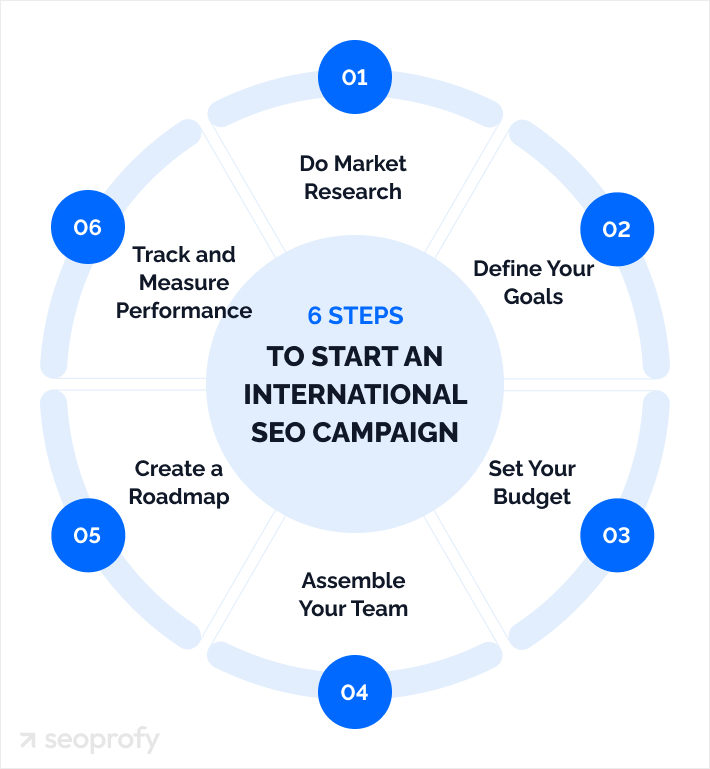
1. Do Market Research
The first thing you need to do before starting a global SEO strategy is to look at the current situation on the market and check if there’s a demand for the service or product that you offer. The best way to do it is to check where your search traffic is coming from and if any trends indicate potential.
For this, go to Reports in your Google Analytics account and select Overview under Demographics. Here, you’ll see the top countries your website visitors are coming from. If you see a lot of traffic from certain regions where you’re not yet targeting, that’s a good sign of demand.
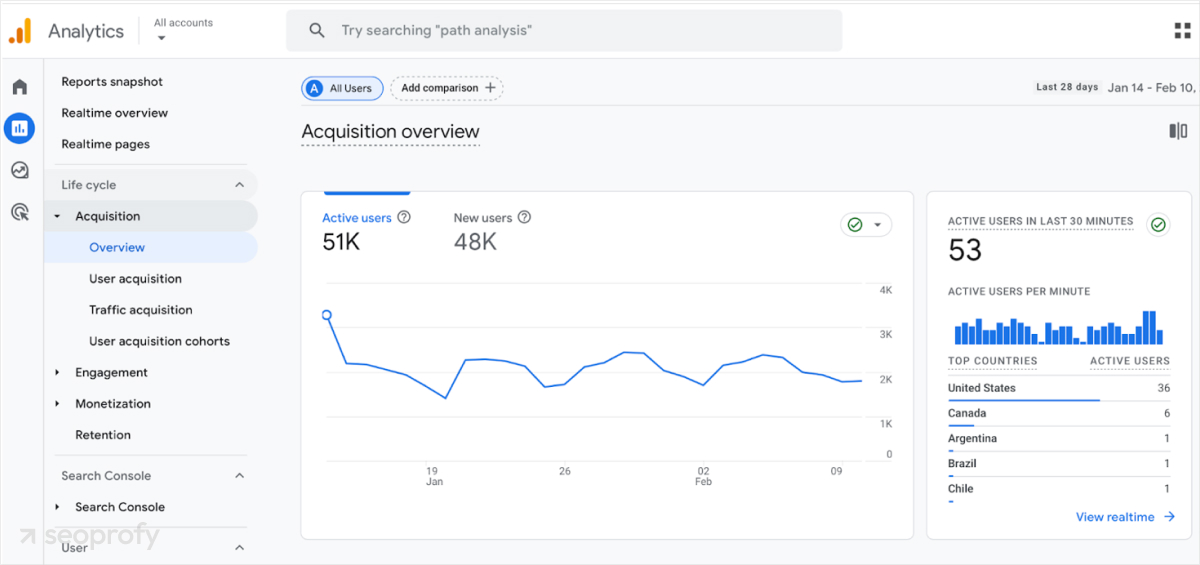
Next, analyze your competition. Search for terms related to your industry in your target countries and look at what sites rank at the top. Note if they are global brands, local competitors, or industry directories. You can do this in Ahrefs, Semrush, or any other SEO tool.
Once you get a sense of the demand, you’ll be in a much better position to decide what countries and languages to go for in your international SEO strategy. This will save you time and money, as not every location will be the right fit for you.
2. Define Your Goals
After the research, it’s time to set your goals. You’ll need to think about what exactly you want to achieve. Are you trying to increase overall website traffic, get more sales in specific countries, or build brand awareness in new markets? Maybe you want all three.
Answers to these questions will shape your SEO strategy, so it’s best to write down your main priorities. This will help you measure your progress and make changes to your strategy as you go.
3. Set Your Budget
The SEO costs for international optimization are often on the higher end. And you need to be upfront about what you can afford to invest. Your budget will determine how many countries you can target and how fast you can scale. Following are some of the expenses you may have:
- Website Translation: You’ll need to hire language experts from each country to localize the content on your website.
- Technical SEO: If you don’t have SEO experts in-house, you’ll need to outsource it to freelancers or an agency. They’ll help you set up hreflang tags, optimize site speed for different countries, and fix site structure.
- Keyword Research: Tools like Ahrefs, Semrush, or SE Ranking are helpful for a global SEO strategy, but can be expensive.
- Link Building: To grow authority and trust in other countries, you’ll need to get backlinks from high-quality sites.
- Content Creation: You’ll also need professional SEO copywriting experts to write high-quality content for your site.
If you have a smaller budget, you might start with just one or two markets and then add new ones as you grow. It’s always a good idea to do a few things well rather than spreading your resources too thin.
4. Assemble Your Team
For your international campaign, you’ll need a team. We’ve already mentioned some of the experts in the earlier section, so now let’s expand on that. For example, you might also need a project manager to keep your campaign organized and on track.
At the same time, if you don’t have in-house experts who specialize in creating an effective international SEO strategy, you’ll need to bring in new people. That could mean hiring full-time, working with freelancers, or partnering with an agency to save time and effort. If you’re weighing your options, check out our guide comparing SEO in-house vs outsourcing.
5. Create a Roadmap
Okay, so now you know your goals, the approximate budget, and who to hire. What’s next? You need a structured plan to help you achieve your goals. It should specify which countries to prioritize and also include:
- The target languages to localize for
- The required technical setup
- The laws and regulations to comply with
- The international keywords to use
- The content to create
- The number of links to build
We’ll go into more detail on each of these in the next sections. You’ll see which tactics to include in your strategy and also how to implement them.
6. Track and Measure Performance
The final step is to regularly check your international SEO performance. You can do it in Google Analytics, Google Search Console, and also in dedicated SEO tools like Ahrefs or Semrush. With these tools, you’ll be able to see:
- How many people are visiting your site from each country
- Ranking positions for the local terms you’re targeting
- The pages that get the most clicks or conversions
- How long people from other countries are staying on your site
It’s a good idea to review SEO numbers often to understand which regions and keywords are attracting the most visitors. If certain countries or search terms perform well, you can optimize your content further to connect with more users in those areas. According to our SEO ROI statistics, it might take 6 to 12 months to see positive ROI from SEO campaigns, so you might not see great results right after launching your campaign.
At SeoProfy, our team has 12+ years of experience in SEO for international sites. We’ll help you see more traffic and conversions from other countries with the help of:
- Extensive site analysis
- Technical SEO fixes
- Localized content
- High-quality link building

What Does an SEO Strategy for an International Site Include?
There are several tactics that go into an international SEO strategy, and in this section, we’ll break them down one by one. Keep in mind that this isn’t a one-and-done process. Search algorithms change all the time, so remember to monitor and adapt your strategy regularly.
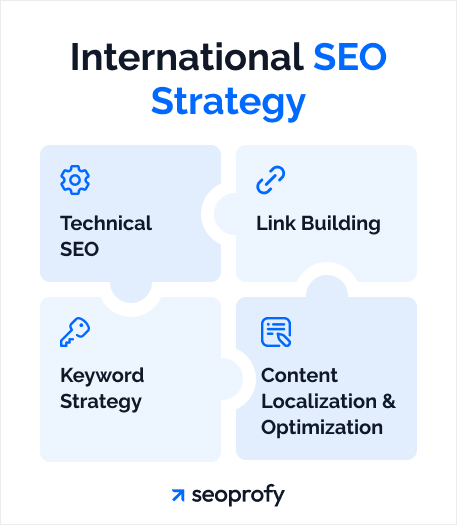
Technical SEO
For your website to show up in search results across different countries, you need a technical setup. Search engines need to understand which version of your site belongs to which audience.
If things aren’t configured correctly, you could end up ranking in the wrong country or, worse, not ranking at all. Here’s what to pay attention to during this step.
Local Hosting (or Not?)
Some time ago, search engines looked at where a website was hosted to determine its target audience. Although this isn’t as important as it once was, server location can still affect page speed, which matters for rankings and user experience.
If your business serves one country, a local server can help your site load faster for users in that region. But if you’re reaching customers in multiple countries, relying on one local server might slow things down for international visitors.
A better solution for a global SEO strategy? Use a Content Delivery Network (CDN). It stores copies of your website on multiple servers worldwide. This reduces load times no matter where your users are.
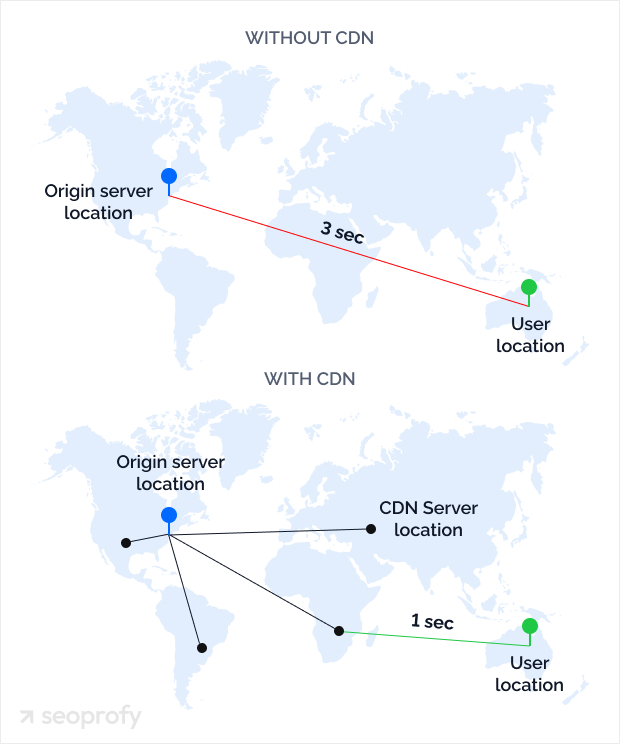
For example, a visitor in Australia won’t have to wait for your site to load from a server in the U.S. They’ll get a faster response from a nearby CDN server instead. So it’s often a better investment than local hosting.
Site Structure
Your website structure influences how search engines rank it in different countries. There are three main ways to set up an international site, each with its own trade-offs.
Country Code Domains (yourbusiness.fr)
These domains show search engines and visitors that a site is meant for a specific country. It’s beneficial for local rankings, but each domain needs its own international SEO strategy. This structure works well for businesses that operate separately in different countries.
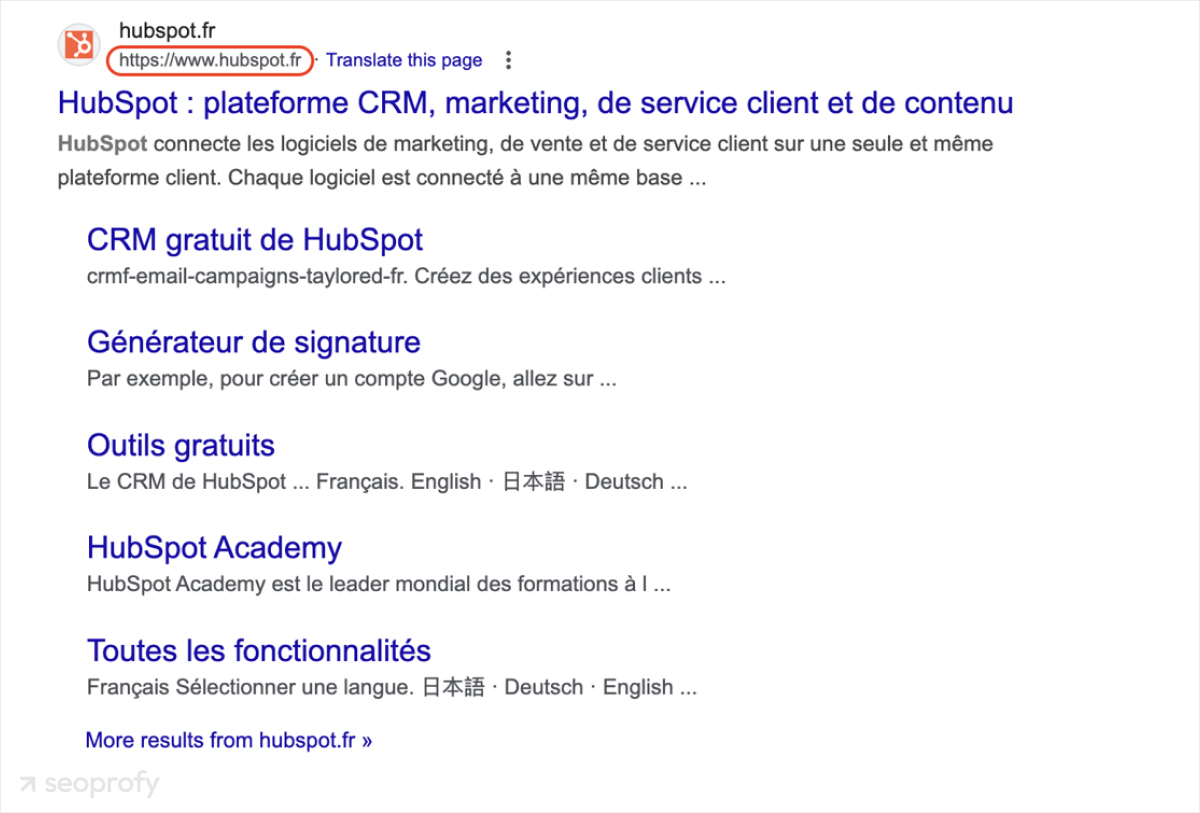
Subdirectories (yourbusiness.com/fr)
With this setup, all content stays under one roof, which simplifies SEO management and is more affordable than running multiple country-specific domains. The downside? It’s not as effective for geo-targeting as ccTLDs. This approach is a good fit for ecommerce, SaaS, and content-heavy websites that want to strengthen their SEO worldwide.

Subdomains (fr.yourbusiness.com)
Subdomains give you the flexibility to manage different markets independently, but Google often sees them as separate sites, which can dilute ranking power. This structure makes sense for large businesses that need distinct sites for each region but still want to keep everything under the same domain.

The choice of a website structure depends on your goals and budget. You’ll need to think about how much separation you need between different markets.
Hreflang Tags
If you’ve ever searched for something online and landed on a page in the wrong language, that’s because someone didn’t use Hreflang tags. So what exactly do they do?
Hreflang tells search engines which version of a page to show based on a visitor’s language and location. This prevents users in Spain from landing on your English site when they should be seeing the Spanish version. Here are some best SEO practices you can follow to set them up:
- Use hreflang tags for each language and country version of your pages.
- Place them in the <head> section of your HTML, in your XML sitemap, or in HTTP headers.
- Always include a self-referencing hreflang tag on each page.
Hreflang is something all multilingual sites need. If you skip it, Google might guess which version to show, and that guess won’t always be right.
Website Speed & Performance
Speed matters. And not only for the user experience on your site but also for your sales. That’s why your Core Web Vitals should be in good health. These measure how fast, stable, and interactive your pages are.
The higher your score, the bigger the chances of rankings everywhere, not just in one country. Luckily, there are several proven ways to improve your international SEO performance across multiple regions:
- Use a CDN to store copies of your site on servers worldwide for faster loading.
- Compress images and serve next-gen formats like WebP.
- Minimize redirects, which can slow things down.
- Host your site on fast and reliable servers.
If your main server is slow, even a CDN won’t fully fix the problem. So that’s something you need to work on first and then continue with the rest of the issues.
Indexing & Crawling Optimization
Before your pages surface on the internet, Google bots need to crawl and index them. If something blocks them from discovering your pages, your website will not show up in the search results.
It could happen because of the multiple languages on your site, duplicate content, as well as other technical issues. To avoid it in your international SEO strategy, you can try to do the following:
- Check your robots.txt file to make sure you’re not accidentally blocking important pages from Google.
- Use canonical tags to prevent duplicates between language versions.
- Submit XML sitemaps of all language versions so search engines can discover them.
You can monitor the number of indexed and unindexed pages in the Google Search Console. Simply go to the indexing section and click on the full report.
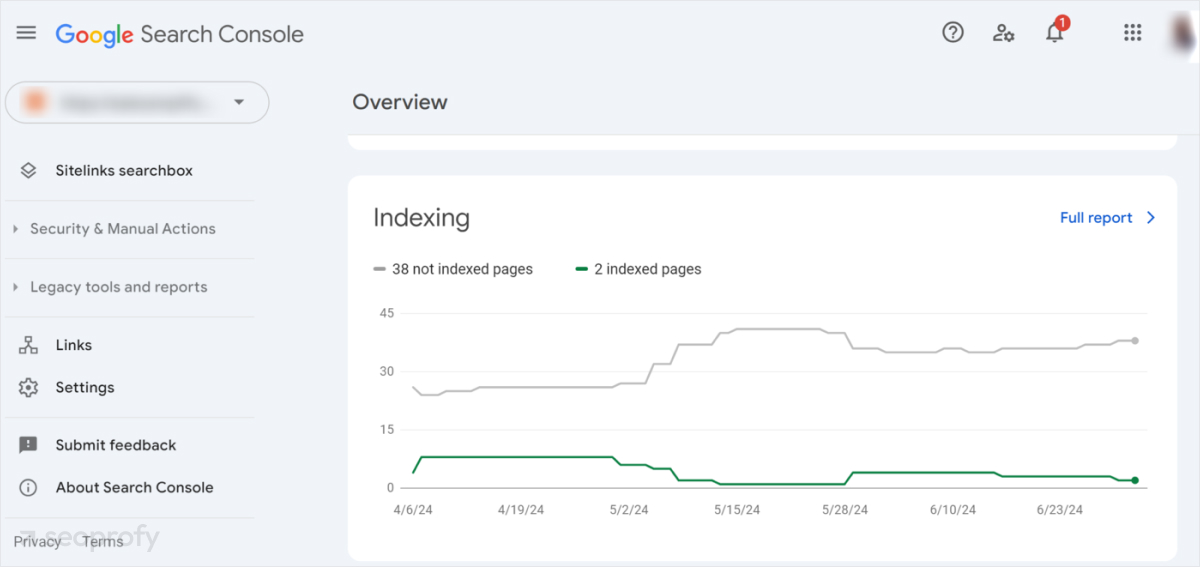
If some of your pages aren’t indexed, even your best content won’t rank. So, remember to check it from time to time and apply the tips we shared above.
Keyword Strategy
An international SEO keyword strategy looks different than if you were targeting people in the same area. That’s because foreign countries have their own slang, cultural references, and ways of searching online.
Even within the same language, words and phrases can vary. For example, “sneakers” in the U.S. might be “trainers” in the UK, and in some countries, searchers may use entirely different terms.
Search intent also changes by market. A keyword that signals buying intent in one country might be used for research in another.
So, a direct translation of keywords won’t be enough. You have to understand what people actually type into search engines.
With all these differences, a better approach for global SEO is to do local keyword research for each country you’re targeting. It can help you find the most relevant and searchable keywords international audiences use.
Tools like Ahrefs, Semrush, or SE Ranking can help you with this. You can use them to find local keyword ideas and see the search volume and keyword difficulty as well as the intent behind them.
Since these tools rely on Google’s data, you might also need to check region-specific tools for countries like China or South Korea, where they use local search engines.
Another thing you could do is look at local competitors. Enter their domain in any SEO tool of your choice and set the country filter to your target market. You can then click on their top-ranking pages to see what keywords drive the most traffic for them.
Content Localization & Optimization
When you’re optimizing your site for multilingual SEO, you need to pay special attention to content localization. But why is it so important?
Localized content helps your site rank for the relevant keywords in each market. But more than that, it lets you speak to your audience in a way that feels familiar and natural to them, which builds trust and can lead to higher ROI from your international SEO efforts.
That said, localization doesn’t only mean content. You’ll also need to adapt the design of your site to match local preferences. For example, here’s how Monday’s homepage looks in the U.S.
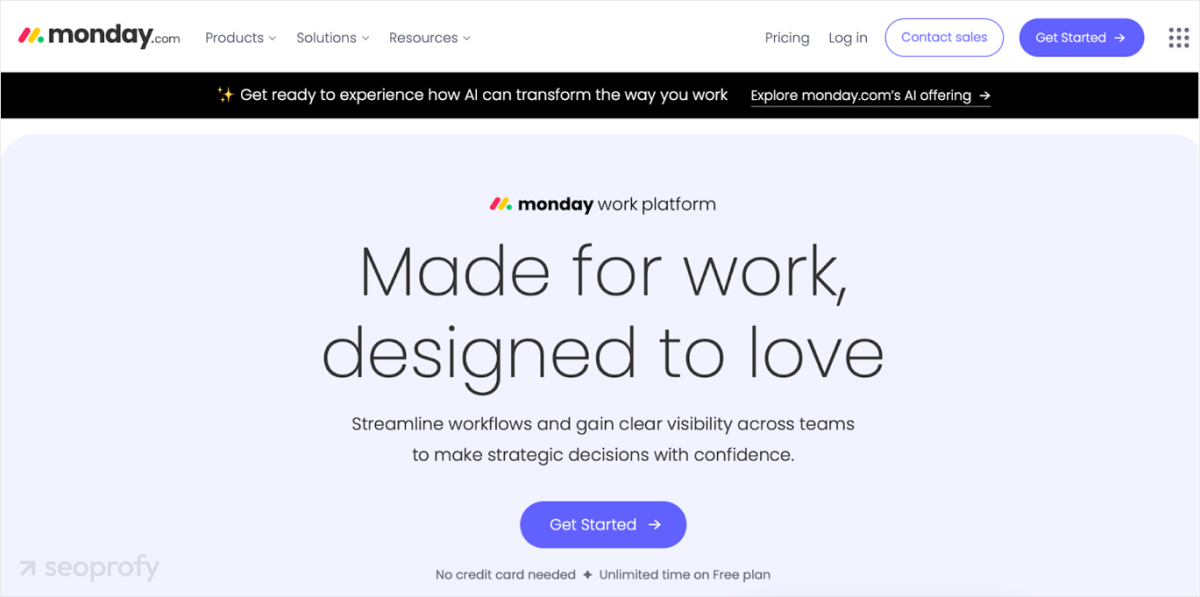
Now, if we look at the same website in France, we’ll see that they changed not only the text but also the layout of the page.
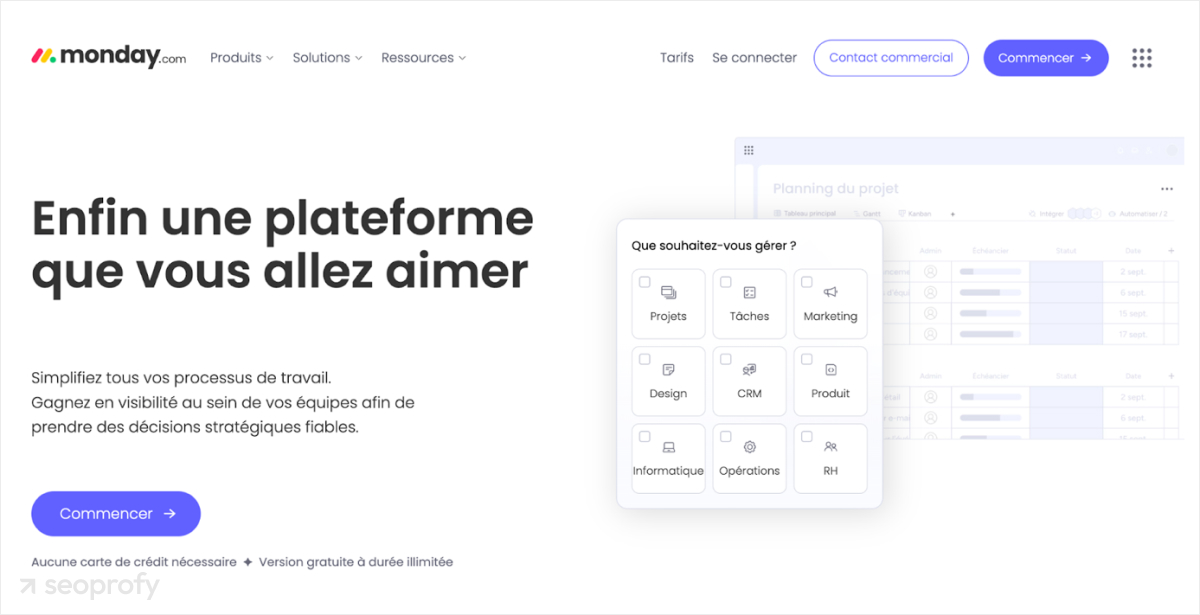
Keep in mind that translation is not the same as localization. The goal of the first one is to directly convert the text from one language into another, focusing on linguistic accuracy. On the other hand, localization takes a more comprehensive approach by tailoring the content to align with the cultural, social, and contextual expectations of the intended audience.
A lot of businesses save time and money by using AI tools for initial translation. And then they bring in language experts to make sure everything sounds natural and fits the local culture.
But don’t forget that you’ll also need to adjust currencies, payment options, addresses, and time zones for your global SEO strategies. Here’s an example of the pricing page on Stripe. This version is adapted for the US audience with the prices in US dollars.
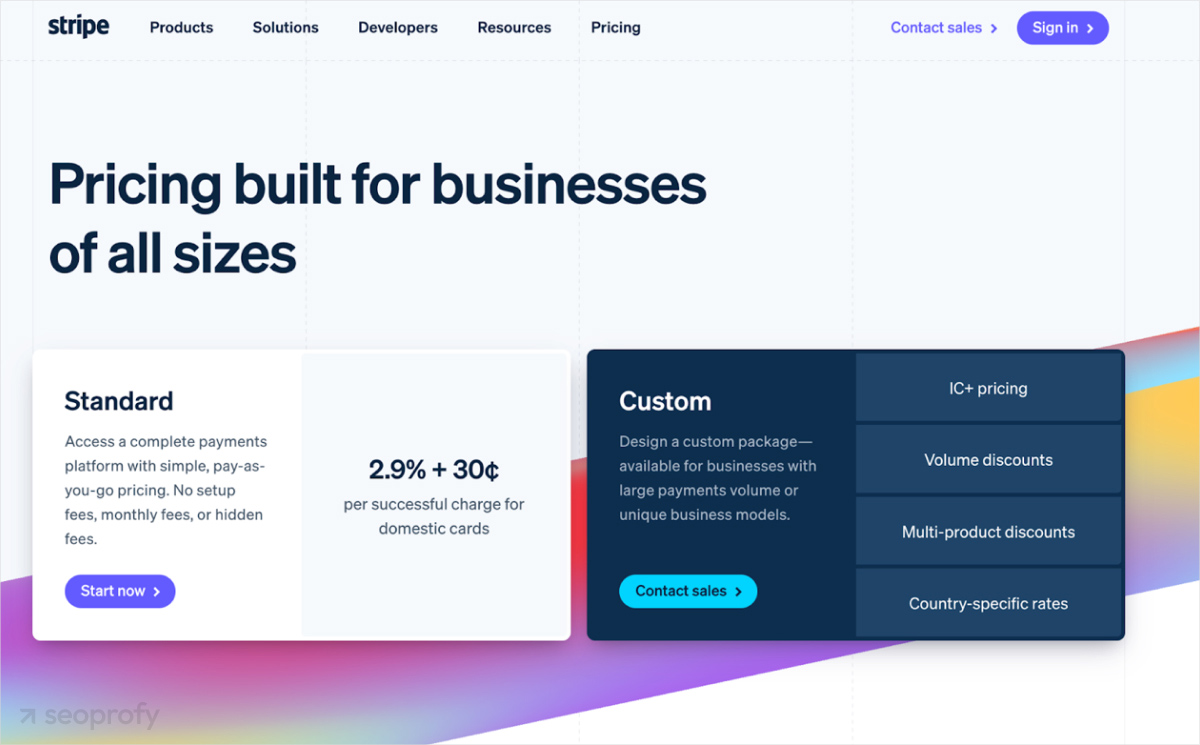
If we look at the same page in France, we can see that it was changed to EUR.
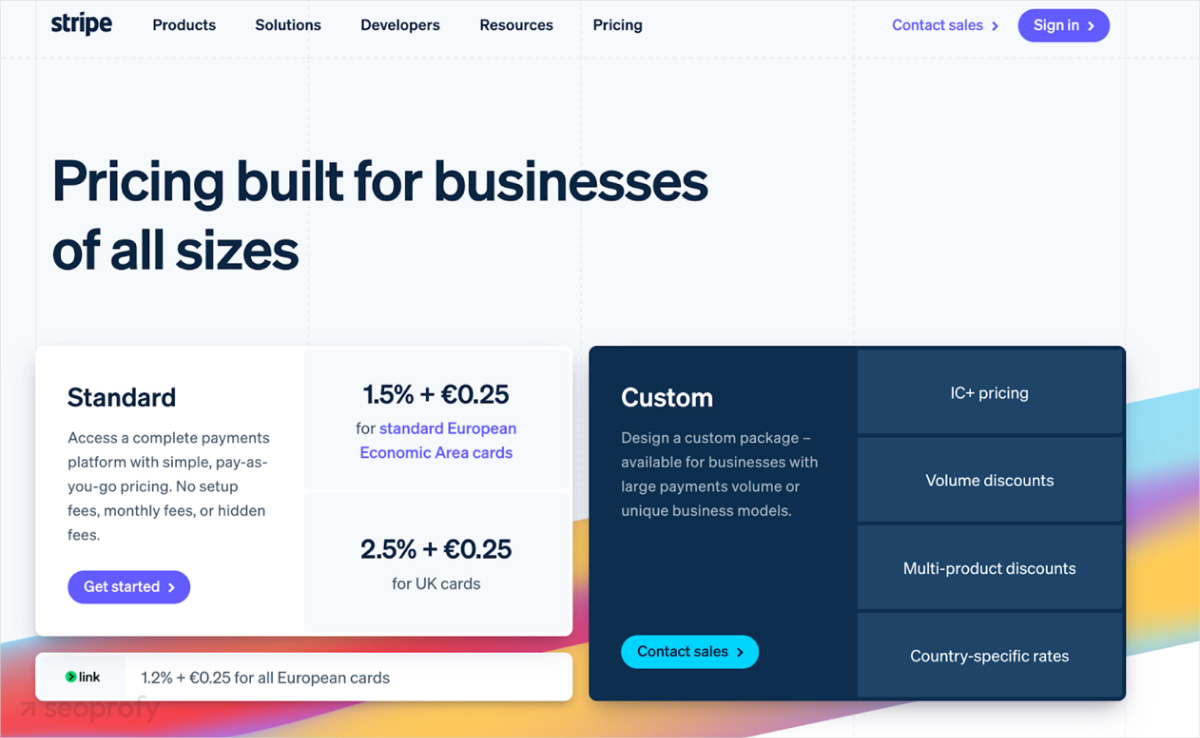
To help you make the most out of your content in international SEO strategies, here are a few tips and best practices to keep in mind:
- Write content that feels relevant to the local culture and interests.
- Create company guidelines you can share with language experts to keep your brand voice consistent.
- Adjust your content strategy to fit local holidays and seasons, especially if you’re in e-commerce.
- Use images, layout, and colors that resonate with each country.
- Try tools like HeyGen to localize product demos and marketing videos.
Although it may seem like content localization is a lot of effort, it definitely pays off. A study by Unbabel found that 84% of marketers say localization has had a positive impact on their revenue growth. That said, you’ll also need to build backlinks to your content to help it rank higher, which leads us to our next section.
Link Building
Link building is another crucial aspect of your international SEO strategy. It helps you get mentions from other sites in your niche, known as backlinks, which are important for ranking and domain authority.
Search engines view them as signals of trust. But not all backlinks hold the same value. Links from websites in your target country carry more weight than those from unrelated sources. To earn backlinks, you can do the following:
- Work with local bloggers and news sites in your industry
- Get your business listed in local directories
- Partner with regional events or charities to earn mentions
You can also check what websites are linking to your local competitors. A helpful tool for this is Ahrefs Backlink Checker.

Here, you’ll see all the sites linking to your competitors. You can filter the results to find relevant sites for your business and try to get mentions from them.
Remember that SEO takes time, and you might not see improvements in rankings or authority with only a few backlinks. It’s a long-term process, and you need to be prepared for it.
Common Mistakes Global Sites Make
There are some SEO mistakes businesses make when starting an international SEO strategy that can impact your performance and results. Below, we’ve listed some of the most common ones and tips to avoid them:
- Auto-translation vs. localization: Auto-translation may seem like a quick fix but it won’t do your content justice. It misses the subtleties and cultural context of different regions, whereas proper localization makes sure your message fits the local market, not just in language but in tone and context.
- Incorrect Hreflang tags: If you don’t configure your Hreflang tags the right way, you’re confusing search engines, and they won’t know which page to show in different regions. This can lead to less visibility and traffic.
- Ignoring local keyword research: Using the same keyword strategy for all regions? That’s also a mistake. Search intent varies from place to place. What works in the U.S. won’t necessarily work in France or Japan. Research the terms to find what people are actually searching for in each market.
- Bad link building: Getting backlinks from irrelevant sites or only focusing on one country won’t get you far. You’ll need high-quality, relevant links from trusted local sites in each market you’re targeting.
How We Scaled One Client with International SEO
At SeoProfy, we’ve helped many clients grow their businesses internationally through our SEO services. One of them was a trading platform.
Their goal was to grow organic traffic by 5x in two years. And with the growth of traffic, they were expecting an increase in First-Time Deposits.
When they came to us, their website had suffered from the Helpful Content Update (August 2022) and Core Update (September 2022). Here’s how the traffic drop looked in Ahrefs:

The first thing we did was conduct an SEO audit. This helped us find several issues with the client’s site:
- Only 40% of their pages (out of 120,000) were indexed by search engines.
- The site had more than 100 language versions, but most of them weren’t indexed and didn’t bring any traffic.
- Almost all backlinks pointed to the English version of the site, while other languages had little authority.
- Their content wasn’t SEO-optimized, and the site structure wasn’t logical.
With all the issues we found, we moved on to a technical SEO analysis and mapped out an SEO strategy with all the areas that needed to be fixed.
We first handled duplicate content issues, changed the site structure, and added internal links. The next step was to improve indexing, which was partially fixed through internal linking. Our team went on to:
- Optimize the website loading speed
- Improve server performance
- Change the image formats to WebP

On the off-page side, we built high-quality backlinks for all language versions. This helped to distribute authority across all languages, not just English.
After all the changes we made to the site, the client was able to see tripled organic traffic (from 1,200 to 4,000 users) and doubled first-time deposits. Here’s our full case study if you’d like to read more.

Wrapping Up
We went through numerous international SEO best practices and pointed out common mistakes to stay away from. Still, every business is different, and what works in theory doesn’t always translate into results. If you feel like your current strategy isn’t bringing the traffic you expected, or you’d just like an expert opinion, reach out to SeoProfy.
Our international SEO agency will run a full audit, and put together a plan to get your multilingual pages indexed, Hreflang set up correctly, and your content properly optimized so you can start seeing more customers and achieve global SEO success.













